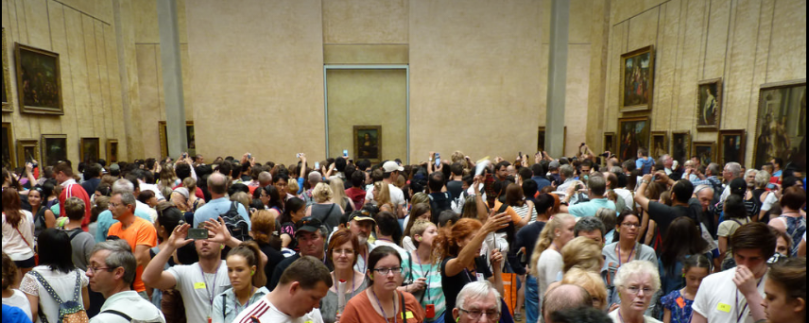More people travel for pleasure today than any other time in history. Mass tourism is not a new term anymore and it seems it is not one we are going to forget any time soon either. The number of tourist only increases from year to year, everywhere around the world. Due to overcrowding however, the most beautiful and spectacular places of the planet become unpleasant to visit. With their presence, too many people turn a unique place into a deserted and meaningless territory. Since in recent years the digital domain becomes ever so large and all-encompassing, speculations suggest that it might in the near future be able to substitute many physical environments and needs such as shopping or communication. This post focuses on the link between the digital and physical in travelling and tourism – what are the dependencies between the two domains and how do they influence each other.
The Louvre is visited by over 9 million people each year. According to the former director of the gallery, most of the visitors come only to glance at the Mona Lisa. This painting has an unprecedented fame that extends well beyond the world of art with virtually everyone knowing this and that about it. And it all started with a theft – in 1911 the Gioconda was stolen and then two years later returned. And despite not being harmed in any way, when the painting came back to the Louvre, nothing was quite the same. In the last two years the name Mona Lisa had been circulating the press headlines and sparked wide public interest. Subsequently, it also began emerging printed on various objects – from book covers to consumer goods such as umbrellas and cups. The more the public saw of Leonardo’s mystery woman, the more the interest grew and so did the visitor count in the Louvre.
Now the famous painting is visited by over 9 million people every year. I doubt that even one succeeded in really beholding its beauty.

And whereas, the Mona Lisa is a painting in a room in a gallery, the effect of over-interest, leading to emptiness expands to the scale of a neighbourhood or even an entire city, as in the case of the smaller Italian cities or most European capitals.
A more recent example of an internet hype turning into a tourism trend is Trolltunga – a scenic cliff in Norway, whose pictures flooded internet sites for dream vacation destinations. The natural wonder inspired many young travellers, prepared or not, to take a nearly 10 hour hike to a secluded area and there take that impressive photo sitting on the rock above a breathtakingly deep cliff. This hype turned dangerous and peaked with a tragic accident.
Overcrowding of sites is a problem – even in cases not as extreme as Norway when one might be physically in danger, our heritage, our nature and our sanity is at stake.
The digital seems to be a large cause of that problem but it may well also be the solution – as the Venice Biennale for art and architecture tried exactly that two years ago. Surprisingly however, releasing the entire content online brought even more visitors in reality than before, which made the organizers happy, but the crowds had to deal with extended queuing time and restricted space in the pavilions.
Digital sources of information and representation become more and more internal to the way we live and work. It is unreasonable to think that that storm will calm and it seems that is true also for the reality of tourism today. However it is becoming more and more alarming that a healthy and symbiotic relationship between the two spheres needs to be established. Solution might not come overnight but for its accumulation, awareness is vital. Next time when in a packed gallery room or bridge in Venice or a queue to a palace – dream of a way we can all enjoy the same precious sites and yet, not have to suffer through each other to do so.

